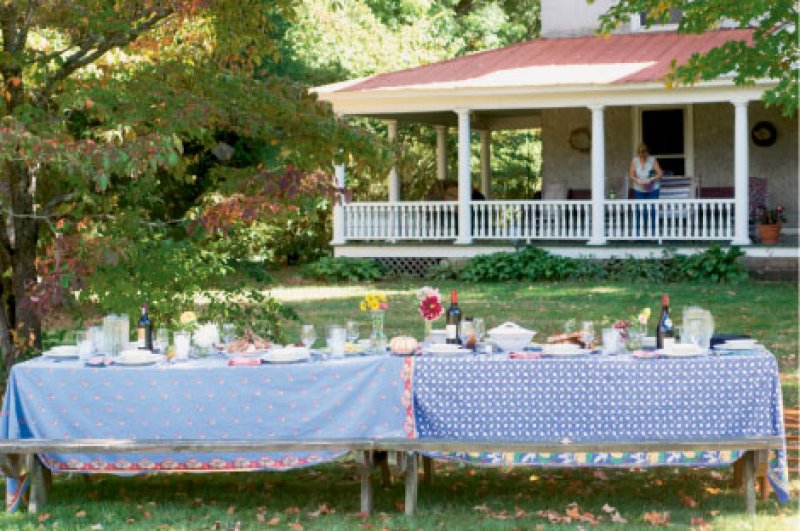The Sweet Life
The Sweet Life: Friends and neighbors share the rewards of a sorghum harvest at the Duckett House Inn & Farm
Wielding machetes, a dozen people wearing jeans and T-shirts hack at rows of sorghum grass in front of the Duckett House Inn & Farm in Hot Springs. The field hands then lop off the fluffy seed pods and strip the thick outer armor, revealing tender, pale stalks. Now the stalks are ready to be pushed through the mill—the pressed juices will be boiled for hours to create golden sorghum syrup.
This is the inn’s annual sorghum harvest, and while the workers, mostly friends and neighbors of inn owners Brian Baker and his partner, Frank Matula, are toiling under a scorching early autumn sun, they have a feast to look forward to at the end of the day. Typically the event is a potluck affair, but this year, Baker is preparing a meal that showcases the smoky-sweet syrup in a variety of dishes and will send the volunteers home with jars of the sorghum from last year’s harvest.
Schooled in the Miami restaurant scene, Baker continues to share his culinary talents at the sprawling, white clapboard B&B. He also handles the front of the house at the nearby Iron Horse Station. Matula, a builder, crafts everything from elaborate barn doors and homes to the copper-accented barn on the grounds that serves as his studio.
The innkeepers adopted the harvest seven years ago, resurrecting a tradition that took place a few miles down the road at Randall Lanier’s farm. Today, Lanier, who donated the grinding mill to the inn, is driving the tractor that propels it. “It’s become a fall community social,” says Baker. “We really try to do it up right.”
Pick Your Own
Today, sorghum syrup isn’t the only ingredient pulled from the yard. During an early morning walk through the garden, past a tangle of foxtail grass and morning glories, Baker picked rosemary, oregano, and thyme for the pork marinade and basil for the risotto. A quick stop at the hen house yielded eggs for the pumpkin pie. “I like cooking with the seasons,” he explains. “It’s very important to me to have a sense of where my food is coming from. It’s a connection to the land around me.”
By midmorning, Baker is as busy in the kitchen as his friends are in the field, roasting corn on the stove-top grill for the corn bread and creating the pie custard from soft, baked chunks of pumpkin. In addition to fragrant cinnamon, ginger, and allspice, Baker pours thick ribbons of sorghum into the filling. Next, he rolls out the chilled dough for a pie shell and pops the dessert in the oven. He checks the pork rack marinating in the refrigerator before finally getting to sample the sweet, iced coffee he made for the workers.
Neighbor Heidi Schaefer helps Baker pour the coffee into tall glasses. Carrying the refreshment out on a tray, an idyllic scene plays out before her. Her four-year-old son, Rainer Schaefer-Huff, is loping around the meadow, dragging the sorghum stalks to the pile that will be fed into the mill. Baker and Matula’s blue heeler, Jack, runs after a ball with the volunteers’ visiting dogs, and several men across the field are stoking a fire underneath an enormous stainless steel basin in preparation for the cooking process that will last late into the night.
“Trying to keep up with the tractor is hard,” Rainer shouts as he follows the machine around in the circle it makes while turning the mill, which gnashes the stalks between metal teeth, and dispenses a cloudy liquid into tin buckets.
The buckets are hoisted onto sunburnt shoulders as the workers take the cane juice from the mill to the basin to be poured through paper filters. It will boil until it’s thick and a deep shade of amber. A hundred gallons of sorghum juice will bubble down to just 10 gallons of syrup.
“Sticking your fingers in the pan and tasting the warm syrup is my favorite part of the harvest,” reflects Matula, who uses the versatile syrup to flavor pancake batter and breakfast breads. Not to be confused with the sweeter and darker molasses, sorghum has a richer, smokier flavor. “I set out a jar with fresh-baked biscuits for our guests, and Brian uses it to glaze meats, like the pork we’re having today,” he says.
Day is Done
Late in the afternoon, a quarter acre of the heirloom honeydrip sorghum has been whittled down to just a few rows. Jackie Bolin, a former Hot Springs resident, made a trip from her home in Minnesota for the occasion.
“I wouldn’t miss it,” she says. “You’re surrounded by all this nature, and there’s an amazing community of friends. It’s pretty cool to imagine this was the way some of the settlers of this area worked.”
Picnics tables have been pulled together under shade trees and set with country linens and wildflowers so the group can eat family style. As side dishes are brought out of the kitchen, the harvesters wash up. Bottles of cold beer are handed out, but also glasses of light red wines that pair well with the glazed pork and other autumnal fare. Baker sets out a pitcher of syrup to complement the savory chops.
A comfortable silence engulfs the table as the weary fortify themselves and survey the naked field before them. Tonight, backs will be sore and fingers blistered, but all is outweighed by a tangible sense of community—that connection between past and present, where neighbors come together for hard work and a shared meal.
